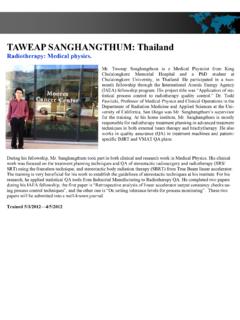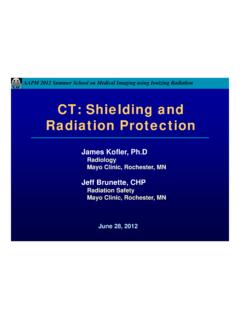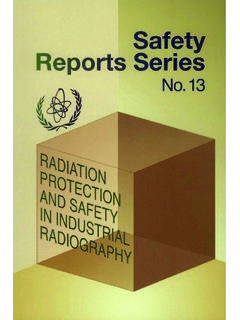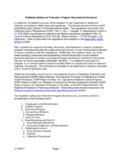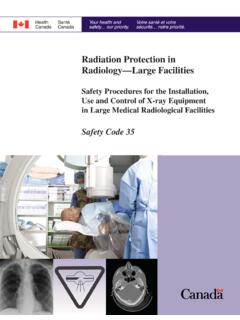Transcription of Chapter 16: Radiation Protection and Safety in Radiotherapy
1 IAEAI nternational Atomic Energy AgencySet of 236 slides based on the Chapter authored byP. Ortiz- Lopez, G. Rajan, and Podgorsakof the IAEA publication: Radiation Oncology Physics:A Handbook for Teachers and StudentsObjective:To familiarize the student with the basic principles of radiationprotection and Safety in 16: Radiation Protection and Safety in RadiotherapySlide set prepared in 2006 by Podgorsak (Montreal, McGill University)Comments to S. Vatnitsky: Oncology Physics: A Handbook for Teachers and Students - OF Radiation International consensus and Radiation Safety Types of Radiation Quantities and units used in Radiation Basic framework of Radiation Governmental regulation and national Scope of the basic Safety Responsibilities for implementation of basic Safety Safety in the design of Radiation sources and Safety of acceptance tests, commissioning and Security of sourceIAEAR adiation Oncology Physics: A Handbook for Teachers and Students - 16.
2 TABLE OF CONTENTS (continued) Occupational Medical Public Potential exposure and emergency General shielding Typical linac Shielding design for brachytherapyIAEAR adiation Oncology Physics: A Handbook for Teachers and Students - Slide INTRODUCTION Soon after Roentgen discovered x rays in 1895 andBecquerel discovered natural radioactivity in 1896 itbecame apparent that ionizing Radiation was not onlyuseful for the diagnosis and treatment of disease butwas also harmful to human tissue through: Direct clinical effects at very high doses. Potential for delayed effects such as induction of malignancies. Potential for genetic Oncology Physics: A Handbook for Teachers and Students - Slide INTRODUCTION Risks associated with Radiation exposure can only berestricted but cannot be eliminated entirely because: Radioactive substances producing ionizing Radiation occurnaturally and are permanent features of the environment. Man-made Radiation sources are now widespread.
3 Sources of ionizing Radiation are essential to modern life, in healthcare, industry, and Oncology Physics: A Handbook for Teachers and Students - Slide INTRODUCTION Health care: Disposable medical supplies sterilized by Radiation are central incombating disease. Radiology and nuclear medicine are a vital diagnostic tool Radiotherapy is commonly used in treatment of cancer. Agriculture: Irradiation is used to preserve foodstuff and reduce wastage. Irradiation-based sterilization techniques are used to eradicatedisease carrying insects and pests. Industry: Industrial radiography is in routine use to examine Oncology Physics: A Handbook for Teachers and Students - Slide Radiation EFFECTS Exposure to Radiation can cause detrimental health effectsthat fall into one of two categories: Deterministic Stochastic In addition to deterministic and stochastic effects in adults,other health effects may occur in infants due to exposureof the embryo or foetus to Radiation , such as: Greater likelihood of leukaemia (stochastic effect).
4 Severe mental retardation and congenital malformations(deterministic effects).IAEAR adiation Oncology Physics: A Handbook for Teachers and Students - Slide Radiation Deterministic effects Deterministic effects occur at relatively large doses andare called deterministic because they are certain to occur,if the dose exceeds a threshold level. Deterministic effects are the result of various processes,mainly cell death and delayed cell division, caused byexposure to large Radiation doses. The severity of a particular deterministic effect in anexposed individual increases with the dose above thethreshold for the occurrence of the Oncology Physics: A Handbook for Teachers and Students - Slide Radiation Stochastic effects Radiation exposure can also induce delayed effects suchas malignancies and hereditary effects, which: Are expressed after a latency period. May be epidemiologically detectable in a population. Are called stochastic effects because of their random nature.
5 This cancer induction is assumed to take place over theentire range of doses without a threshold level: The probability of occurrence of cancer is higher for higher doses. The severity of cancer that may result from irradiation isindependent of Oncology Physics: A Handbook for Teachers and Students - Slide Radiation Stochastic effects Stochastic effects may ensue if an irradiated cell ismodified rather than killed, since modified cells maydevelop into a cancer after a prolonged delay. If a cell damaged by Radiation exposure is a germ cellwhose function is to transmit genetic information toprogeny, it is conceivable that hereditary effects ofvarious types may develop in the descendants of theexposed individual. The likelihood of stochastic effects is presumed to beproportional to the dose received without a Oncology Physics: A Handbook for Teachers and Students - Slide INTERNATIONAL CONCENSUS AND Radiation Safety STANDARDS Radiation Safety standards are based on knowledge ofradiation effects and on established principles of radiationprotection.
6 The United Nations Scientific Committee on the Effects ofAtomic Radiation (UNSCEAR) was set up by the UnitedNations in 1955 to compile, assess and disseminateinformation on: Health effects of Radiation . Levels of Radiation exposure due to various Oncology Physics: A Handbook for Teachers and Students - Slide INTERNATIONAL CONCENSUS AND Radiation Safety STANDARDS Purely scientific considerations are only part of the basisfor decisions on Protection and Safety ; an importantcomponent is also value judgment on the relative risks ofdifferent kinds and on the balancing of risks and benefits. General acceptance of risk is a matter of consensus andthe international Safety standards should provide adesirable international consensus for the purpose ofradiation Oncology Physics: A Handbook for Teachers and Students - Slide INTERNATIONAL CONCENSUS AND Radiation Safety STANDARDS International consensus is basic to theIAEA Radiation Safety standards, whichare prepared with the wideparticipation of and approval by itsMember States as well as relevantinternational organizations.
7 The current version of the safetystandard was issued in 1996 and isentitled International Safety Standardsfor Protection against IonizingRadiation and for the Safety ofRadiation Sources , in short BasicSafety Standard (BSS).IAEAR adiation Oncology Physics: A Handbook for Teachers and Students - Slide TYPES OF Radiation EXPOSUREThe BBS defines two types of exposures: Normal exposure results from certain industrial or medicalpractices and is of predictable magnitude albeit with somedegree of uncertainty. Potential exposure is an unexpected but feasible exposurethat can become actual exposure, if the unexpectedsituation does occur, for example, as a consequence ofequipment failure, design problems or operating Oncology Physics: A Handbook for Teachers and Students - Slide TYPES OF Radiation EXPOSUREThe BBS specifies means for controlling normal and potentialexposures: Normal exposures are controlled by restricting the dosedelivered. For example, exposure of patients is controlledthrough delivering only the doses that are necessary toachieve the diagnostic or therapeutic objective.
8 Potential exposures are controlled by optimizing thedesign of installations, equipment and Oncology Physics: A Handbook for Teachers and Students - Slide TYPES OF Radiation EXPOSURE The Radiation exposures covered by the BBS encompassnormal and potential exposures of three distinct groups: Workers pursuing their occupations (occupational exposures). Patients in diagnosis or treatment (medical exposures). Members of the public. Radiation exposures are thus divided into three categories: Occupational exposure. Medical exposure. Public Oncology Physics: A Handbook for Teachers and Students - Slide TYPES OF Radiation EXPOSURE Occupational exposure is defined as all exposures ofworkers incurred in the course of their work. Medical exposure is defined as the exposure incurred: By patients as part of their medical diagnosis or treatment. By individuals, other than those occupationally exposed, whilevoluntarily helping in the support and comfort of patients.
9 By volunteers in a programme of research involving their exposure. Public exposure is defined as exposure incurred bymembers of the public from Radiation sources, excluding anyoccupational or medical Oncology Physics: A Handbook for Teachers and Students - Slide QUANTITIES AND UNITS IN Radiation Physical quantities Most of the requirements of the BBS are qualitative, yet theyalso establish quantitative limits and guidance levels. Radiation exposure originates from natural or man-maderadionuclides or from special equipment producing ionizingradiation. The main physical quantities used in Safety standards arethe activity and the absorbed Oncology Physics: A Handbook for Teachers and Students - Slide QUANTITIES AND UNITS IN Radiation Physical quantities The activity of an amount of a radionuclide in aparticular energy state at a given time is given as: is the decay constant of the radioactive nucleus is the number of radioactive nuclei at time t.
10 Is the half-life of the radioactive nucleus. A(t) A(t)=dNdt= N(t)=ln 2t1/ 2N N(t)1/2tIAEAR adiation Oncology Physics: A Handbook for Teachers and Students - Slide QUANTITIES AND UNITS IN Radiation Physical quantities The SI unit of activity is 1 s-1 and its name is the becquerel(Bq), representing one nuclear transformation (disintegrationor decay) per second, , 1 Bq = 1 s-1. The older unit of activity is the curie (Ci), s-1 ( , 1 Ci = Bq). The curie was initially defined as the activity of 1 gram ofradium-226; however, refined measurements have shownthat the activity of 1 g of Ra-226 is Oncology Physics: A Handbook for Teachers and Students - Slide QUANTITIES AND UNITS IN Radiation Physical quantities The absorbed dose D is defined as: is the mean energy imparted to matter of mass dm. The SI unit for absorbed dose is 1 J/kg and its name is thegray (Gy). The older unit of absorbed dose is the rad, representing100 erg/g, , 1 Gy = 100 cGy = 100 rad.



